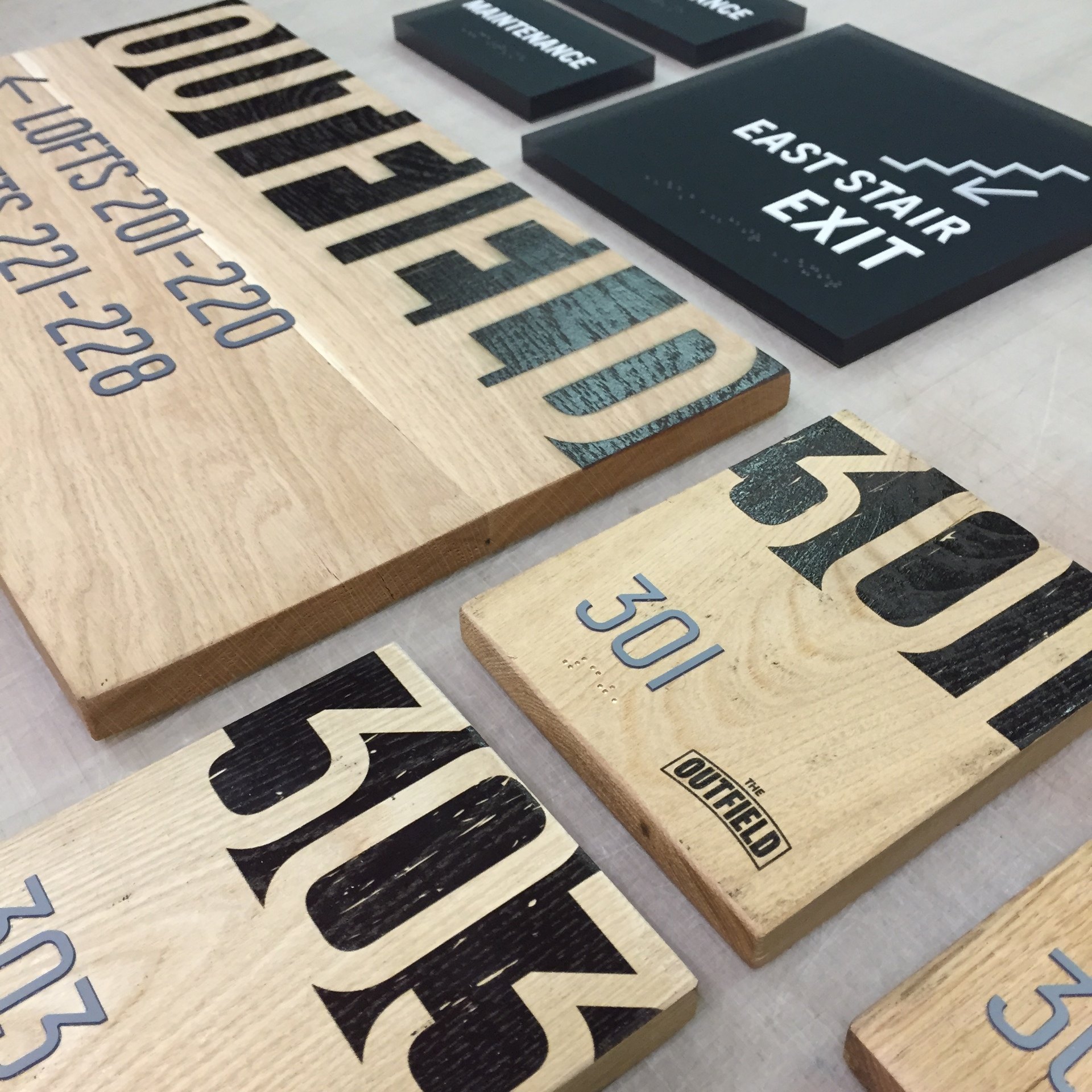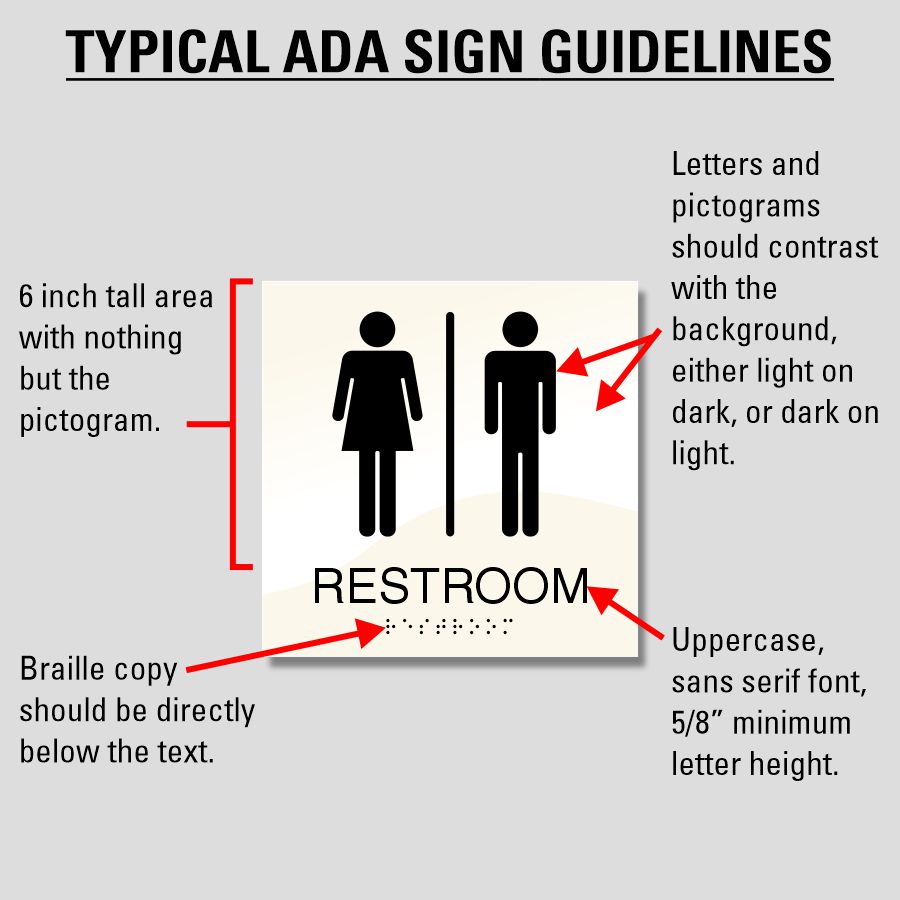Customizing ADA Signs to Satisfy Your Certain Demands
Wiki Article
Discovering the Key Features of ADA Indications for Boosted Access
In the world of availability, ADA indications offer as silent yet powerful allies, making certain that areas are inclusive and navigable for individuals with impairments. By integrating Braille and responsive components, these signs break barriers for the visually impaired, while high-contrast shade plans and readable fonts cater to varied visual demands.Value of ADA Conformity
Ensuring compliance with the Americans with Disabilities Act (ADA) is important for cultivating inclusivity and equivalent access in public rooms and work environments. The ADA, passed in 1990, mandates that all public centers, companies, and transportation solutions fit individuals with handicaps, guaranteeing they delight in the very same civil liberties and chances as others. Conformity with ADA criteria not just fulfills lawful responsibilities yet likewise enhances an organization's reputation by showing its commitment to diversity and inclusivity.One of the crucial elements of ADA compliance is the implementation of obtainable signage. ADA signs are designed to make certain that individuals with handicaps can easily navigate via buildings and areas.
In addition, adhering to ADA regulations can reduce the threat of possible penalties and legal repercussions. Organizations that stop working to follow ADA guidelines may face penalties or claims, which can be both financially challenging and harmful to their public photo. Therefore, ADA conformity is indispensable to cultivating a fair environment for everybody.
Braille and Tactile Elements
The unification of Braille and responsive components into ADA signs symbolizes the principles of access and inclusivity. These functions are vital for people who are blind or visually damaged, enabling them to navigate public areas with higher freedom and confidence. Braille, a responsive writing system, is important in offering created information in a format that can be easily viewed via touch. It is typically placed underneath the equivalent text on signs to make sure that individuals can access the info without aesthetic aid.Responsive components extend past Braille and consist of increased characters and symbols. These components are created to be noticeable by touch, enabling individuals to determine space numbers, toilets, exits, and other vital locations. The ADA sets particular standards regarding the dimension, spacing, and positioning of these responsive aspects to optimize readability and ensure uniformity across various atmospheres.

High-Contrast Shade Schemes
High-contrast color design play a critical duty in enhancing the presence and readability of ADA signage for people with aesthetic problems. These plans are vital as they maximize the distinction in light reflectance between message and background, ensuring that signs are easily noticeable, also from a distance. The Americans with Disabilities Act (ADA) mandates the usage of specific color contrasts to accommodate those with restricted vision, making it a critical aspect of conformity.The effectiveness of high-contrast shades exists in their capacity to stick out in numerous illumination problems, including dimly lit environments and locations with glow. Commonly, dark text on a light background or light text on a dark background is utilized to achieve optimum comparison. As an example, black text on a yellow or go white background supplies a raw visual distinction that assists in fast recognition and comprehension.

Legible Fonts and Text Dimension
When considering the design of ADA signage, the option of readable typefaces and ideal text size can not be overstated. These aspects are critical for ensuring that signs come to individuals with visual impairments. The Americans with Disabilities Act (ADA) mandates that fonts should be not italic and sans-serif, oblique, manuscript, very attractive, or of uncommon type. These demands assist ensure that the text is easily legible from a distance which the characters are appreciable to diverse audiences.The size of the message likewise plays a pivotal duty in access. According to ADA standards, the minimum message height must be 5/8 inch, and it needs to enhance proportionally with watching range. This is particularly vital in public areas where signage requirements to be read promptly and accurately. Uniformity in text size contributes to a natural visual experience, aiding individuals in browsing settings efficiently.
Furthermore, spacing between letters and lines is essential to clarity. Ample spacing avoids personalities from showing up crowded, improving readability. By adhering to these criteria, designers can dramatically improve availability, making certain that signage serves its desired function for all people, no matter their aesthetic capacities.
Reliable Placement Methods
Strategic positioning of ADA signs is vital for taking full advantage of availability and guaranteeing compliance with legal requirements. Effectively positioned indications guide individuals with handicaps properly, facilitating navigation in public rooms. Key factors to consider include closeness, height, and exposure. ADA standards state that signs ought to be mounted at a height in between 48 to 60 inches from the ground to ensure they are within the line of sight for both standing and seated people. This conventional height array is essential for inclusivity, enabling wheelchair customers and people of varying elevations to accessibility info easily.In addition, indications must be put nearby to the lock side read here of doors to allow very easy identification prior to entrance. Consistency in indication positioning throughout a facility boosts predictability, reducing complication and improving overall individual experience.

Final Thought
ADA indicators play an essential duty in advertising access by incorporating functions that attend to the needs of people with handicaps. These components jointly promote a comprehensive setting, highlighting the value of ADA compliance in ensuring equal accessibility for all.In the realm of ease of access, ADA signs offer as quiet yet effective allies, making sure that areas are accessible and comprehensive for people with handicaps. The ADA, established in 1990, mandates that all public centers, companies, and transportation solutions suit people with impairments, guaranteeing they appreciate the same rights and chances as others. ADA Signs. ADA indications are made to ensure that individuals with specials needs can quickly navigate via structures and spaces. ADA standards state that indicators must be mounted at an elevation between 48 to 60 inches from the ground to ensure they are within the line of view for both standing and seated individuals.ADA indications play an important duty in promoting access by incorporating attributes that attend to the requirements of people with specials needs
Report this wiki page